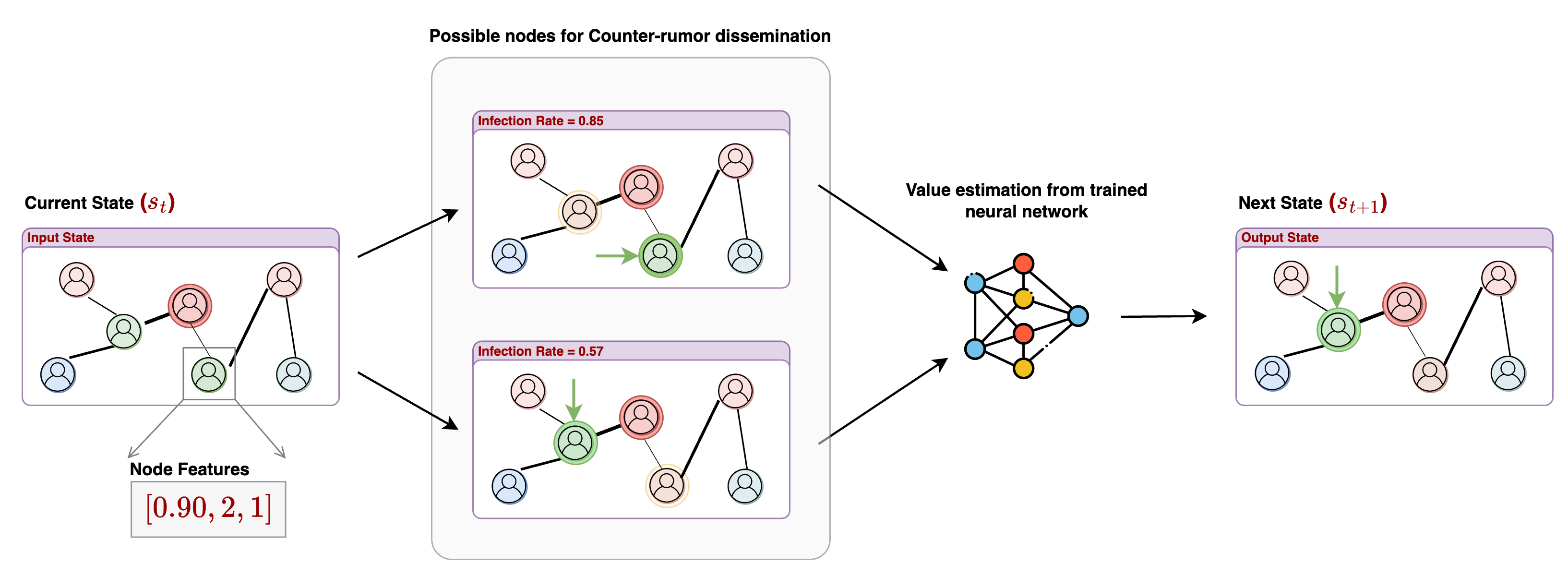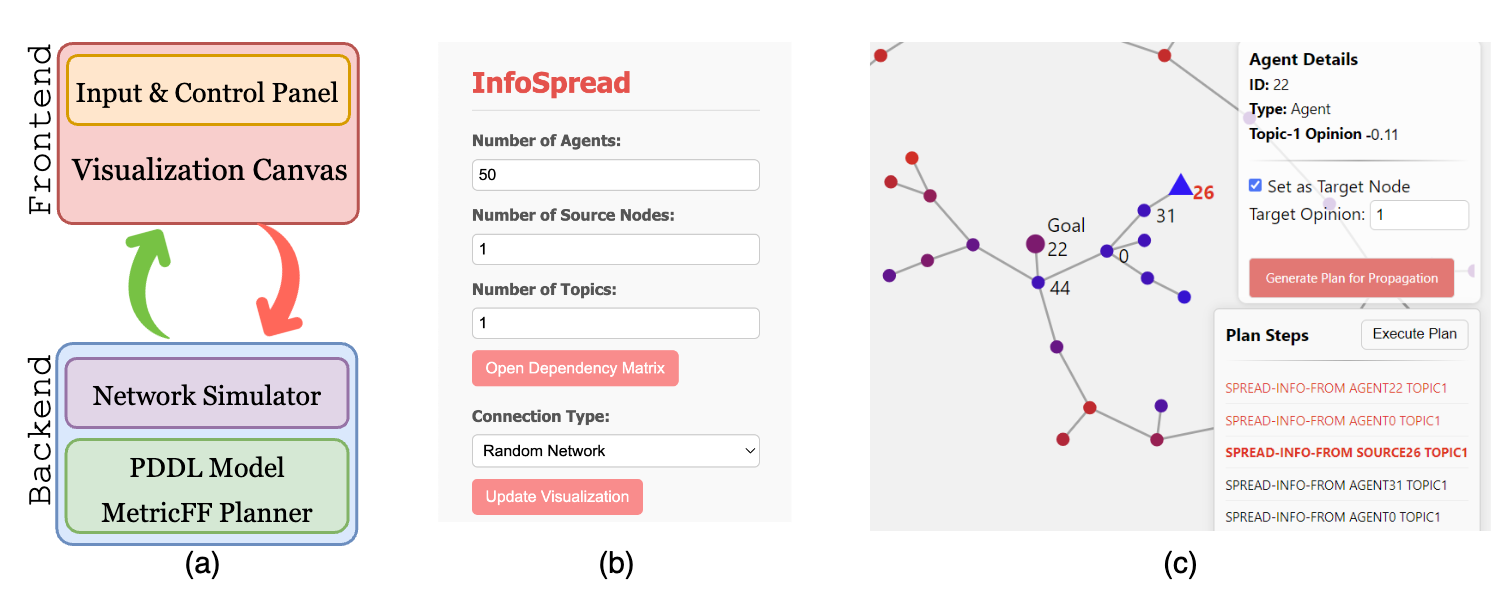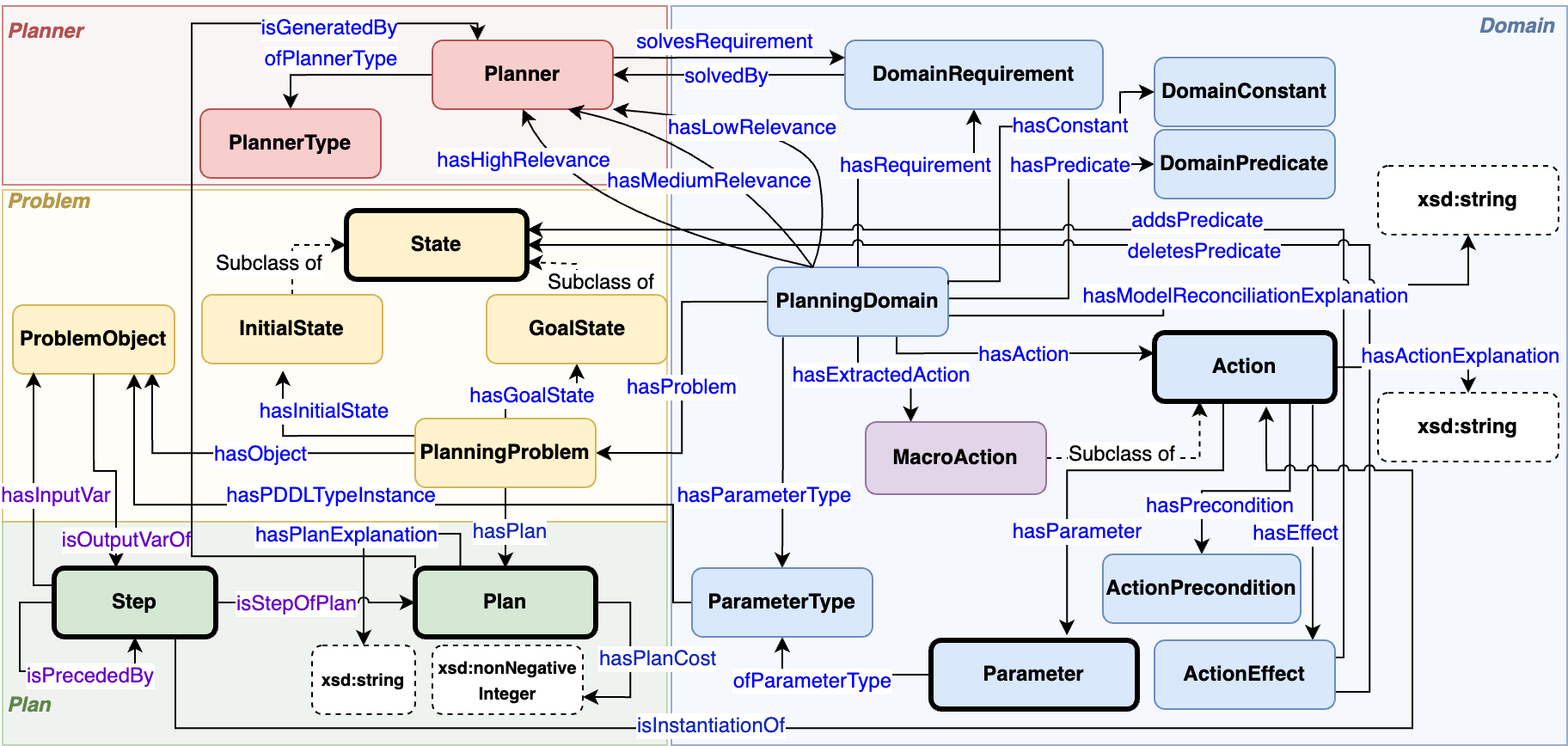Research Projects
Opinion Dynamics & Information Spread in Networks
Research on modeling, simulating, and controlling opinion dynamics in social networks using automated planning, learning, and reinforcement learning. Focuses on misinformation control, intervention strategies, and interactive visual tools.
Related Publications
Towards Effective Planning Strategies for Dynamic Opinion Networks
Expressive and Flexible Simulation of Information Spread Strategies
Planning Strategies for Dynamic Opinion Networks
Models information propagation and opinion change as a numerical planning problem over network states. Proposes a ranking-based labeling method to identify influential nodes and target them for interventions. Introduces a reinforcement learning planner (GCN-based) that learns when and where to intervene by balancing infection rate, susceptible populations, and budget constraints.

Learning-based framework enabling strategic interventions in opinion networks.
Simulation of Information Spread Strategies
An interactive simulator that uses planning models to explore "what-if" information spread strategies over networks. Users can visualize opinion evolution under different interventions, analyze trade-offs, and understand how targeted actions affect long-term outcomes. Recognized with the Best Demo Award at AAAI 2024.

Interactive simulation tool for opinion dynamics.
Planning Ontologies & Multi-Agent Explanations
Developing ontologies to capture planning knowledge for both single-agent and multi-agent systems. This work bridges the gap between raw planner logs and human-understandable explanations, enabling semantic queries and performance improvements.
Related Publications
OMEGA: An Ontology-Driven Tool for Explaining Multi-Agent Path Finding
Building a Plan Ontology to Represent and Exploit Planning Knowledge
Planning Ontology & maPO
Designed a planning ontology to capture domains, problems, plans, and performance metadata. Extended this to multi-agent planning with maPO, a schema that models agents, conflicts, and joint plans. This enables semantic queries (SPARQL) to answer questions about planner performance and generate natural language explanations.

Overview of the planning ontology structure.
OMEGA: Explanations for MAPF
OMEGA is an ontology-driven tool that uses maPO to provide explanations for Multi-Agent Path Finding (MAPF). It explains why collisions occur, how agents are rerouted, and what trade-offs are made, in human-understandable language.
Multi-Agent Path Finding & Planning Algorithms
Work on path finding and search in multi-agent settings: MAPF with hybrid learning, ontology-based explanations, and benchmarking domain-independent planners on challenging combinatorial puzzles like the Rubik's Cube.
Related Publications
Scalable Multi-Agent Path Finding using Collision-Aware Dynamic Alert Mask and a Hybrid Execution Strategy
Solving the Rubik’s Cube With a PDDL Planner
Comparing Rubik’s Cube Solvability in Domain-Independent Planners
Hybrid Learning Framework for MAPF
Proposes a hybrid framework combining decentralized reinforcement learning with lightweight centralized coordination to enable scalable, privacy-preserving, and collision-free MAPF. Achieves significant reduction in information sharing compared to traditional distributed methods.
Rubik’s Cube Planning
Explores how classical planners handle the Rubik’s Cube using standard PDDL representations. Benchmarks multiple planners, analyzing search behavior and scalability, connecting these insights to future learning-based methods.
Large Language Models for Planning
Investigates how LLMs can support or perform planning, how they compare to classical planners, and how they can be used for decision support (e.g., financial advising).
Related Publications
On the Prospects of Incorporating LLMs in Automated Planning and Scheduling
Plansformer: Demonstrating Generation of Symbolic Plans With Transformers
Solving Planning Problems with LLMs
Develops datasets and benchmarks for using LLMs in planning tasks. Analyzes various architectures and introduces models like Plansformer for generating symbolic plans from text/structured inputs.
SafeChat
Designs and evaluates conversational agents aimed at promoting voter participation in a safe, usable, and trustworthy manner. Explores design choices that avoid misinformation, bias, and confusion while aiding voter education.
Related Publications
On Safe and Usable Chatbots for Promoting Voter Participation
Focused on designing conversational agents that can effectively and safely assist users with voter registration and information, ensuring trustworthiness and usability in civic contexts.